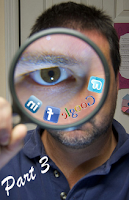 If you are on the fence or haven’t given the platform serious thought why not consider?
If you are on the fence or haven’t given the platform serious thought why not consider?Twitter:
1. Is the best news feed: If you’re following a few reputable sources of news you’ll quickly learn that more often than not you’ll hear about the news first on Twitter. Over time you’ll also pick up other good sources of news and before you know it you’ll be as dependent on Twitter for news as any of your more traditional sources.
You do need to be smart and remain skeptical of unlikely sounding news until it is confirmed by multiple sources, but nevertheless for timely news Twitter is hard to beat. You can find some of the most popular news sources on Twitter here: The top 25 most viral news sources.
2. Is a great learning tool: The University of Twitter, if you like. By following people who share good content that is relevant to you, your career and/or your stage of life you get a constant stream of useful information. And, best of all, it comes to you in manageable 140-character bursts – if you want more, you click the link. This article might help: Choosing Who To Follow On Twitter.
3. Allows complete control of what you see: You only see content from people you choose to follow. You can block any people who follow you and you don’t want to be associated with. And best of all it is completely transparent therefore although there are spammers they are few and far between (and often shut down in minutes if not hours).
If someone does send you an "@" message (public message directed at you and you don’t like what they are saying and/or didn’t ask for it) you can tag them as a spammer and block them.
There are also numerous ways to organize your Twitter stream from tools such as Tweetdeck and Hootsuite – see 10 Twitter Tools Used by Social Media Experts – to simpler approaches such as Twitter lists.
4. Makes better connections than other social media: You follow people who share interesting content and that is often material retweeted (RT) from someone they follow. This way you can check out new Twitter profiles and find interesting people to connect with on Twitter. One of the biggest differences between Facebook and Twitter is that the former is closed (you have to be friends with others to chat) and on the latter you don’t.
I’m connected to people around the world – many of whom I feel I know quite well although our only interactions for several years now have been via Twitter. When traveling I try to meet these people in real life and it is always a rewarding experience. Here are some tips on how to grow your Twitter presence.
5. Makes you a better writer: Before you dismiss this too quickly, think about this: In Twitter you need to say something of value in 140 characters or less – a lot less if you’re going to include a URL and leave room for others to retweet your message. This forces you to think about word choices (as well as teaching you a lexicon of creative abbreviations). This might be helpful: The Art of Writing Great Twitter Headlines.
6. Builds communities of interest: Joining a regular tweetchat on a topic you care about will get you in front of others and a chance to find more interesting people to follow. A tweetchat is when people follow a given hashtag (#smgrchat, a social media community manager chat, for example) at a given time each week or month. Someone moderates by posing questions and anyone can jump in with their answers or their own questions. This is a great professional development opportunity. To find a chat on a topic you care about: List of Tweetchats By Day of Week.
One big reason NOT to join Twitter
If you’re only interested in connecting with family and friends you should stick to Facebook. Everything on Twitter is public unless you protect your tweets. If you protect your tweets you won’t get many followers (Who wants to follow a hidden account?), so really, what’s the point?
So, are you convinced? Will you join Twitter now?
Related posts:
Twetiquette: 10 basics for Twitter politeness
Twitter "Expert" or Twitter "Twit"?
10 Tips for Better Business Tweeting








